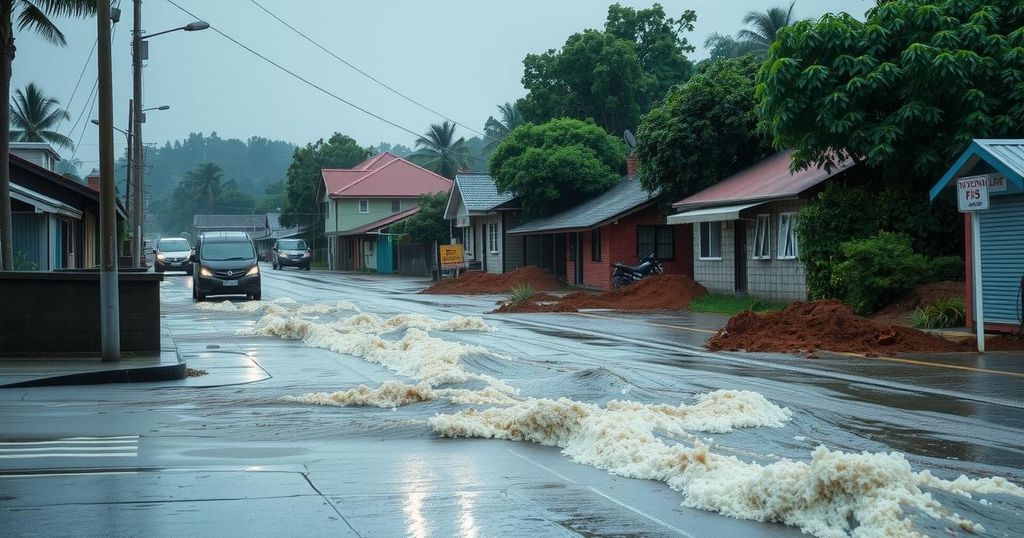Mayotte has been hit by further heavy rains from storm Dikeledi, leading to flooding and mudslides, one month after Cyclone Chido’s devastation. Authorities have declared a red alert as emergency shelters house over 14,500 displaced residents, with expectations of continued rain. The island faces a critical recovery situation as it endures the consequences of two major storms in quick succession.
The island territory of Mayotte, located in the Indian Ocean, has been severely affected by additional heavy rainfall, resulting in significant flooding and mudslides. This catastrophe follows the destruction caused by Cyclone Chido, which left a considerable impact on the islands just one month prior, claiming numerous lives. As the second storm, named Dikeledi, approached, local authorities declared a maximum state of alert, warning residents of potential flash floods and landslides.
Videos circulating on social media depict extensive power line damage and flooding, particularly highlighting the southern village of Mbouini, which had previously escaped the devastation brought by Cyclone Chido. Dikeledi made landfall in northern Madagascar, resulting in three fatalities and proceeded to pass near Mayotte, approximately 100 kilometers south, according to Météo-France. François-Xavier Bieuville, the prefect of Mayotte, noted that the region was already experiencing the initial impacts of the storm with significant rainfall causing floods and mudslides.
Local emergency response teams have established shelters for over 14,500 residents forced from their homes due to deteriorating conditions. Expectations are that Mayotte will remain under red alert well into Monday evening as torrential rains are forecasted to persist even after the storm’s passage. Currently, the storm is deemed to be moving away from Mayotte and is anticipated to strengthen into a tropical cyclone as it approaches the coast of Mozambique, although it is not projected to make landfall in that region.
Mayotte is currently grappling with the aftermath of Cyclone Chido, which had previously claimed 120 lives across the region. Official statistics indicate that Mayotte’s population stands at approximately 320,000; however, estimates suggest that up to 200,000 undocumented migrants may also reside within its confines. Cyclone Chido, which struck on December 14, is recorded as the most powerful storm to impact Mayotte in nearly a century, unleashing winds that reached 260 km/h, obliterating structures throughout the archipelago.
Mayotte is an archipelago situated between Madagascar and the African continent, characterized by its strategic location in the Indian Ocean. It is regarded as one of the poorest territories of France, facing various socio-economic challenges. Due to its geographical position, it frequently experiences extreme weather events, such as cyclones, which can lead to devastating impacts on the local population and infrastructure. The region has a significant number of undocumented migrants, contributing to the complexity of the humanitarian situation. Cyclone Chido, which occurred recently, has heightened the vulnerability of the islanders, leading to a precarious recovery environment as another storm strikes shortly thereafter.
In summary, Mayotte is currently facing critical challenges due to the dual impact of recent storms, compounded by existing socio-economic vulnerabilities. The island is in a state of alert as heavy rains from storm Dikeledi contribute to further flooding and mudslides, following the catastrophic impacts of Cyclone Chido just weeks prior. With a significant portion of its population displaced, the need for ongoing humanitarian support and infrastructural recovery is more crucial than ever as residents strive to rebuild their lives in the aftermath of these disasters.
Original Source: www.bbc.com






